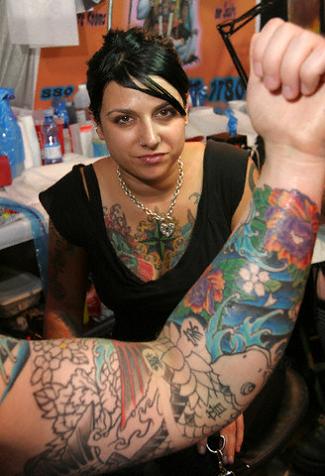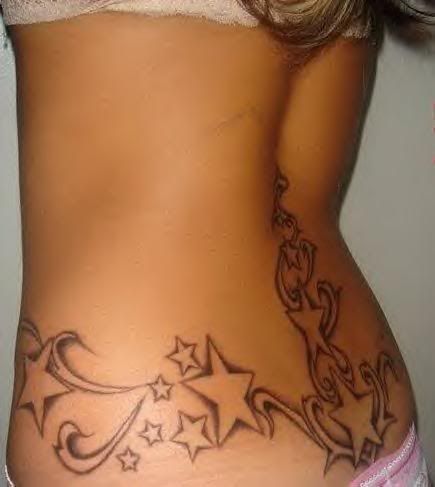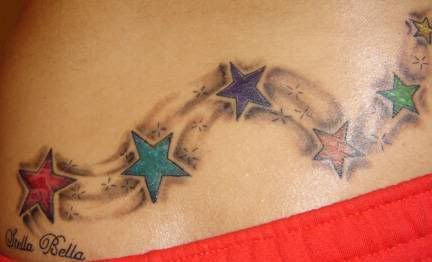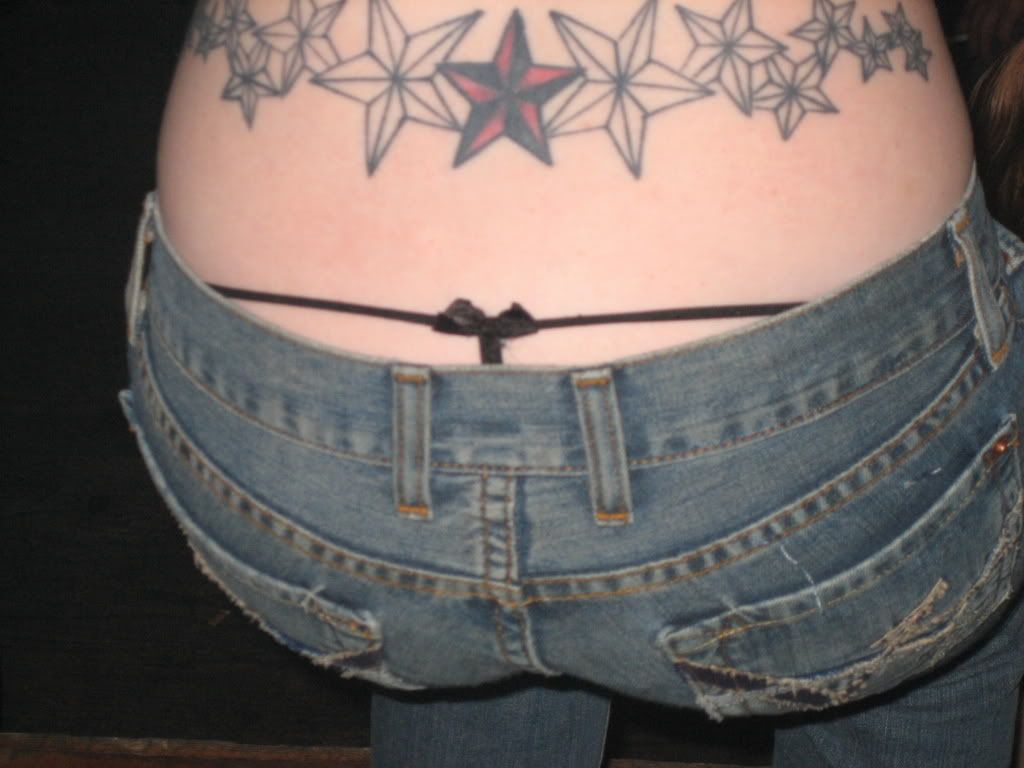Tattoo making is an ancient art; born out of the quest for body beautification. This art had been popular with both the men and women of ancient times, and this has carried into the modern world as well. In different parts of the world men and women alike are getting tattoos done on their bodies. The inherent need is both beautification and also to express themselves and their ideas. A tattoo makes you stand out and sometimes become a part of your identification. Chinese Letters Tattoos
Chinese Letters Tattoos
If you are reading this, you are most probably going to get a tattoo or are thinking about getting one. It is a good thing to research properly and thoroughly before deciding on a tattoo in order to ensure lifetime satisfaction. There is a wide range of tattoos to select from. They contain images, phrases, lyrics, letters, characters, symbols and just your own name as well.
But the tattoo designs that have been gaining rapid popularity these days are the Chinese letters tattoos. So many people are getting one or more Chinese letters tattoos on their body. Mostly it is due to the beauty of the Chinese letters. The Chinese hieroglyphs are both mysterious and exquisite. Chinese Letters Tattoos
Chinese Letters Tattoos
The Chinese letters tattoos can say a lot more than the same number of letters can in any other alphabet.
The tattoos are made using needles to get the colored pigmentation under the skin. The result is permanent. Getting a tattoo is a painful process and the level of pain is directly related to how close to the bone it is. The closer to the bone the needle goes, the more painful it will be. A lot of care should be taken after getting a tattoo. The fresh tattoo should never be allowed to dry. It should be kept moist, otherwise some of the ink comes out and the design gets spoiled.
If you want to get Chinese letters tattoos, you should first take your time and research well. It's not a good idea to just get a tattoo because it looks good, you should also know what the tattoo means and if it is going with your personality. If you do not think carefully before getting a tattoo, chances are that you might later discover that you can no longer keep the tattoo as it is totally opposed to your personality and ideals. Instead of getting a tattoo and then getting it removed after a few years, it's better to spend sometime looking for the perfect one for you. Removing a tattoo is a far more painful process than putting it on. And the cost it incurs is very high as well.
Tattoo, Tattoos, Free Tattoo Designs, Tattoo Gallery, Tattoo Design, Tribal Tattoos, Celtic Tattoos, Tattoos designs, cross tattoos, tribal tattoo
Design Chinese Letters Tattoos
For Sexy Girls Star Tattoos
Girl on party show the Dragon Tattoo Designs
 A girl with the spirit of showing permanent dragon tattoo in the back body at the birthday party of a friend. Tattoo designs are made with precision and a combination of measured tattoo ink.
A girl with the spirit of showing permanent dragon tattoo in the back body at the birthday party of a friend. Tattoo designs are made with precision and a combination of measured tattoo ink.
Hot Sexy Butterfly Tattoos For Women
Japanese Tatto Design Exspesially Japanese Sleeve Koi Fish Tatto Picture Gallery
 Japanese Tattoo Designs Especially Japanese Sleeve Koi Fish Tattoos Picture 1http://bodytattoos-xyarif.blogspot.com/
Japanese Tattoo Designs Especially Japanese Sleeve Koi Fish Tattoos Picture 1http://bodytattoos-xyarif.blogspot.com/ Japanese Tattoo Designs Especially Japanese Sleeve Koi Fish Tattoos Picture 2
Japanese Tattoo Designs Especially Japanese Sleeve Koi Fish Tattoos Picture 2 Japanese Tattoo Designs Especially Japanese Sleeve Koi Fish Tattoos Picture 3
Japanese Tattoo Designs Especially Japanese Sleeve Koi Fish Tattoos Picture 3 Japanese Tattoo Designs Especially Japanese Sleeve Koi Fish Tattoos Picture 4
Japanese Tattoo Designs Especially Japanese Sleeve Koi Fish Tattoos Picture 4 Japanese Tattoo Designs Especially Japanese Sleeve Koi Fish Tattoos Picture 5
Japanese Tattoo Designs Especially Japanese Sleeve Koi Fish Tattoos Picture 5 Japanese Tattoo Designs Especially Japanese Sleeve Koi Fish Tattoos Picture 6
Japanese Tattoo Designs Especially Japanese Sleeve Koi Fish Tattoos Picture 6 Japanese Tattoo Designs Especially Japanese Sleeve Koi Fish Tattoos Picture 7
Japanese Tattoo Designs Especially Japanese Sleeve Koi Fish Tattoos Picture 7 Japanese Tattoo Designs Especially Japanese Sleeve Koi Fish Tattoos Picture 8
Japanese Tattoo Designs Especially Japanese Sleeve Koi Fish Tattoos Picture 8 Japanese Tattoo Designs Especially Japanese Sleeve Koi Fish Tattoos Picture
Japanese Tattoo Designs Especially Japanese Sleeve Koi Fish Tattoos Picture  Japanese Tattoo Designs Especially Japanese Sleeve Koi Fish Tattoos Picture 10
Japanese Tattoo Designs Especially Japanese Sleeve Koi Fish Tattoos Picture 10Butterfly Tattoos
Latest Design Tattoo For Women Art
Latest Design Tattoo For Women Art
 New updates from most popular tattoo design grouping who are really interested in tattoo world know about the trendiest tattoo design that is Cherry develop tattoo so now your selection Cherry develop tattoo design. Cherry develop tattoo designs are very popular tattoo way for stylish teen ladies. Look the complete design of Cherry develop tattoo is inked on the back of a blistering girl and gift the spicy look to her. Fantastic this tattoo way is not exclusive devoted to fashion and style but it also represents power, delicacy and mystery. This tattoo way consists of Hindoo Om in the center the whole look of this new and very interesting tattoo design is simply great. The style gain by cherry develop tattoo chick seems to be of symbolic significance concerned with this tattoo as she has got it inked on her whole back. All teen ladies get your tattoos now in completely new look. One of the most significant tattoo trends of today is the best among all you have seen before because this is based on our conceive for ancient never-dying soul from ancient times but there are two types of person one who conceive and other who do not conceive never-dying soul so today’s uncovering constellation tattoo is especially fashioned for people who conceive on power of change. It is an pertinent tattoo for those who conceive in nativity or want to fete the win after reaching back to a better life. constellation tattoo designs are very attractive and stylish and available in uncountable designs include tribal phoenix tattoo, phoenix Tattoo Company, phoenix tattoo shops, and Japanese phoenix tattoo and many more. This sign of depicting rebirth is most popular and cherished tattoos. The unique and incredible look of the shuttle is what makes this tattoo really attractive so undergo power of phoenix tattoo inspired by the mythological story of the phoenix bird.
New updates from most popular tattoo design grouping who are really interested in tattoo world know about the trendiest tattoo design that is Cherry develop tattoo so now your selection Cherry develop tattoo design. Cherry develop tattoo designs are very popular tattoo way for stylish teen ladies. Look the complete design of Cherry develop tattoo is inked on the back of a blistering girl and gift the spicy look to her. Fantastic this tattoo way is not exclusive devoted to fashion and style but it also represents power, delicacy and mystery. This tattoo way consists of Hindoo Om in the center the whole look of this new and very interesting tattoo design is simply great. The style gain by cherry develop tattoo chick seems to be of symbolic significance concerned with this tattoo as she has got it inked on her whole back. All teen ladies get your tattoos now in completely new look. One of the most significant tattoo trends of today is the best among all you have seen before because this is based on our conceive for ancient never-dying soul from ancient times but there are two types of person one who conceive and other who do not conceive never-dying soul so today’s uncovering constellation tattoo is especially fashioned for people who conceive on power of change. It is an pertinent tattoo for those who conceive in nativity or want to fete the win after reaching back to a better life. constellation tattoo designs are very attractive and stylish and available in uncountable designs include tribal phoenix tattoo, phoenix Tattoo Company, phoenix tattoo shops, and Japanese phoenix tattoo and many more. This sign of depicting rebirth is most popular and cherished tattoos. The unique and incredible look of the shuttle is what makes this tattoo really attractive so undergo power of phoenix tattoo inspired by the mythological story of the phoenix bird.Tattooed mummy, baptized the Lady of Cao, discovered in Peru

A female mummy, baptized the Lady of Cao, with complex tattoos on her arms has been found in a ceremonial burial site in Peru, the National Geographic Society reported Tuesday. Archaeologists say is one of the best-ever relics of a civilization that ended more than 1,300 years ago.
The mummy was accompanied by ceremonial items including jewelry and weapons, and the remains of a teenage girl who had been sacrificed, archaeologists reported. Such a complete array has never been seen before in a Moche tomb.
The presence of gold jewelry and other fine items indicates the mummy was that of an important person, but anthropologist John Verano of Tulane University said the researchers are puzzled by the presence of war clubs, which are not usually found with females.
Peruvian archaeologists, under the direction of lead scientist Régulo Franco, made the discovery last year at an ancient ceremonial site known as El Brujo - “the Wizard”.
The tomb lay near the top of a crumbling pyramid called Huaca Cao Viejo, a ruin near the town of Trujillo that has been well known since colonial times.
Verano said the finding is the first of its kind in Peru, and he likens it to the discovery of King Tut's tomb in Egypt.
"We have an entire repertoire of a very high status tomb, preserved perfectly," Verano said.
The burial site that held the tattooed mummy was part of an ornate enclosure holding four graves, at a ceremonial site known as El Brujo — “the Wizard” on Peru’s north coast, near Trujillo.
They said the woman was part of the Moche culture, which thrived in the area between A.D. 1 and A.D. 700. The mummy was dated about A.D. 450.
The woman had complex tattoos, distinct from others of the Moche, covering both arms and other areas. Bone scarring indicated the woman had given birth at least once. The cause of her death was not apparent.
Verano said she would have been considered an adult in her prime. Some Moche people reached their 60s and 70s.
The grave also contained headdresses, jewelry made of gold and semiprecious stones, war clubs, spear throwers, gold sewing needles, weaving tools and raw cotton.
“Perhaps she was a female warrior, or maybe the war clubs and spear throwers were symbols of power that were funeral gifts from men,” Verano said. In the thousands of Moche tombs previously exposed, no female warrior has been identified.
Mummy an "Astonishing" Find
Verano, who has been working with the El Brujo project since 1995, said the area is "one gigantic cemetery" that has been scoured by grave-robbers for centuries.
But the newly found funerary chamber had been sealed from both looters and the elements since around A.D. 450.
The Peruvian team found the complete burial array intact and perfectly preserved, down to the white cotton wrappings of the mummy bundle.
"It's astonishing," said Moche authority Christopher Donnan, an anthropologist at the University of California, Los Angeles, who was not part of the excavation. "This is far and away the best preserved Moche mummy that has ever been found."
The find is described in the June issue of National Geographic magazine.
The Peruvian team is funded by the Augusto N. Wiese Foundation and Peru's National Institute of Culture.
Verano's research is funded by the National Geographic Society's Committee for Research and Exploration. (National Geographic News is part of the National Geographic Society.)
The Moche
The culture of the Moche, who constructed the largest adobe pyramid in the Americas, the Moche Sun Pyramid, developed along Peru's northern coast near what is now the country's third-largest city Trujillo. It flourished in the river valley oases from 100 A.D. to 800 A.D. The Lady of Cao dates to 450 A.D.
The Moche were later conquered by the Chimus, who were known for elaborate irrigation systems and built Chan Chan, one of the world's largest adobe cities.
They in turn were conquered by the Incas, who built a civilization that stretched from the Equator to the Pacific coast of Chile and are best known for the Machu Picchu citadel in southern Peru.
Their rule came to an abrupt end in the 1530s when they were subjugated by the Spanish Conquistadors.
The Moche's Huaca Cao Viejo pyramid is covered in reliefs that suggest prisoners were sacrificed to the gods by a warrior-priest. It was abandoned for centuries.
Moche pottery has been the main way that experts had interpreted their culture. The ceramics showed the Moche had well-developed weaving techniques, but because of rainstorms every few decades, most of their textiles have been destroyed.
-
Lady of Cao, Pre-Inca woman
-
Fashionable Pre-Inca woman found in Peru pyramid
-
A Peruvian Woman of AD 450 Seems to Have Had Two Careers
-
Marked Pre-Inca Woman at Peru's northern coast
-
Weapons found with Pre-Inca Woman
-
Archaeologists in Peru have discovered a 15-century-old tattooed Moche woman
-
Mysterious Pre-Inca woman unearthed in Peru
-
Tattooed 5th century Pre-Inca woman with jewelry found in Peru
-
Pre-Inca Woman found in ancient site
-
Pre-Inca Woman a warrior princess?
-
First female Moche leader discovered in Peru
new tattoo will be visible and clearly readable
Japanese Tattoo Art: Japanese Tattoo Symbols and Designs

The beauty of the Japanese landscapes, woodcut art forms and watercolors have all been long since admired for their tranquility and beauty. And, they have also been represented by the beautiful art of tattooing. The Japanese art of tattooing has many names, two of the most common being – irezumi and horimono. Irezumi is the traditional word for a tattoo that is visible on the body and covers a large surface area, like the back. Yes, tattoo art has a long and rich history in Japan.
Due to the early influences of Buddhism and Confucianism on the Japanese people and their culture, the art of tattooing has always had a somewhat negative connotation for most of the people. The Japanese tattoo is considered to be the mark of the yakuza, who is a member of the Japanese mafia.
The Early History of the Japanese Tattoo Art
Archaeologists have said that the first few settlers of Japan, the Ainu people, used to use facial tattoos. There have also been several documented reports about the 'Wa' people – which is the Chinese name for the Japanese people – who were said to dive into the water in search of fish and shells and who decorated their entire bodies with tattoos. These documents date back to almost 1700 years ago.
However, the Chinese culture was very highly developed and for them the act of tattooing was considered to be barbaric. When Buddhism was brought into Japan from China, it also brought along with a very strong Chinese influence and thus, tattooing was perceive as negative. Criminals were tattooed o identify and punish them in society.
Modern Japanese Tattoo Art
Although many of the younger generation find the whole concept of tattooing fashionable and trendy, most of the Japanese population still considers it to be something that is linked to the underworld of gangsters and mafia.
Most of the younger generation however, tend to get tattoos on their upper arms where it cannot be directly visible. But, with the Western influences gaining in popularity all over Japan, tattoos are now being shown off more frequently than it once was.
Japanese Tattoo Symbols and Designs
Japanese tattoo symbols and designs dates back as far as 5000 BC. It is also highly possible that the art of tattooing in Japan could have existed well before this date. Japanese clay figurines that date right back to the 5th Millenia BC have also been found with their faces engraved or painted so as to represent tattoos. As far as archaeologists and historians can tell, tattoos in the olden days were believed to have held a special magical or religious meaning to the bearers.
Kanji is a calligraphy style of letter writing that is used by the Japanese. It is indeed a widely popular choice amongst those who are looking for the best Japanese tattoo symbols or designs. By using this kanji method, you can create as well as display any message that you want to. Most of the popular kanji characters displayed today translate into a number of words and emotions such as love, happiness, laughter, wealth, lovers, beautiful, sadness, loyalty and duty.
From beautiful, exotic flowers to fierce Japanese dragon tattoos, or even large intricately designed samurai warriors, Japanese tattoo symbols and designs work for everyone and anyone. A Japanese koi fish tattoo swimming lazily across a woman's hip, a tiny ring of beautiful cherry blossoms fused together as an armband or at the ankle, a fierce looking emerald serpent slithering up someone's calf, or a samurai warrior and a lady embracing on a back – as wonderful as this art of Horimono seems to be – you might very well find yourself being lured into getting all of these beautiful Japanese symbols and designs made on your body. After all, you can never stop at one can you?






















